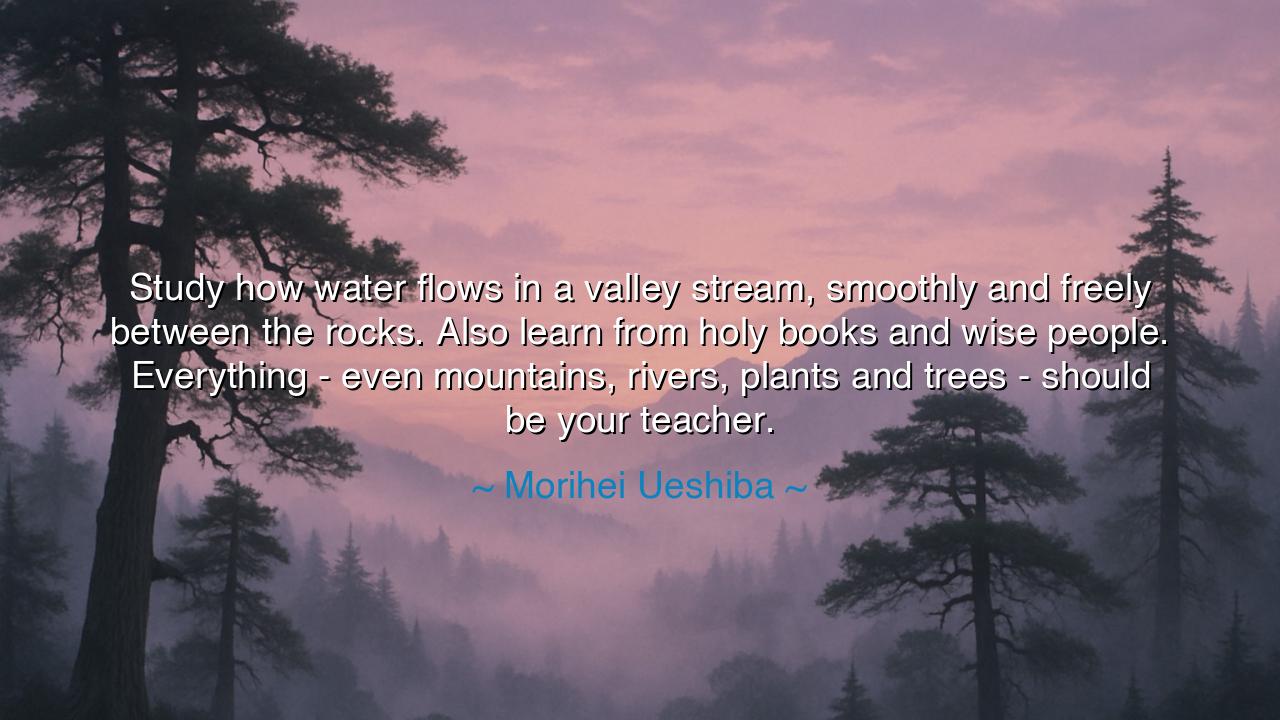
Study how water flows in a valley stream, smoothly and freely
Study how water flows in a valley stream, smoothly and freely between the rocks. Also learn from holy books and wise people. Everything - even mountains, rivers, plants and trees - should be your teacher.






Hearken, seekers of wisdom, to the words of Morihei Ueshiba, the founder of Aikido, who spoke with clarity and depth: "Study how water flows in a valley stream, smoothly and freely between the rocks. Also learn from holy books and wise people. Everything—even mountains, rivers, plants, and trees—should be your teacher." In this teaching lies a meditation on the universality of learning, the subtle lessons embedded in nature, and the harmony of observation, reflection, and practice.
The first revelation is the lesson of water, the archetype of flexibility, patience, and persistence. Water encounters rocks not with force, but with grace and continuity, shaping its path while maintaining its essence. So too should the seeker of wisdom navigate the obstacles of life, moving with awareness, adapting without losing integrity, and allowing challenges to shape rather than shatter the spirit. Water teaches that strength is not always in resistance, but in the power of smooth, enduring motion.
Ueshiba also exhorts the student to learn from holy books and wise people, reminding us that guidance exists not only in nature but in the accumulated knowledge and insight of humanity. By listening to the words of sages and scholars, one gains perspective, discernment, and ethical grounding. Yet this learning is not mere memorization; it is the careful integration of wisdom into one’s own actions, harmonizing human insight with the lessons drawn from the natural world.
Consider the life of Leonardo da Vinci, who observed nature with relentless curiosity, studying rivers, birds, plants, and human anatomy. He combined this observation with study of texts, philosophy, and the work of earlier thinkers. From mountains to streams, from manuscript to laboratory, Leonardo saw everything as a teacher, and in this integration, he became a genius whose vision transcended his age. Ueshiba’s words echo in Leonardo’s approach: to learn from all that surrounds us is to awaken the mind fully.
The metaphor of mountains, rivers, plants, and trees as teachers reminds us that the world itself is a repository of wisdom. Each form and process demonstrates principles of resilience, growth, and balance. The towering mountain shows endurance and stillness; the river demonstrates adaptation and flow; the plant embodies patience and cyclical renewal. To ignore these lessons is to blind oneself to the teaching of life itself.
Ueshiba’s guidance extends beyond observation to practice. Like the water flowing through rocks, the knowledge gained from nature, sacred texts, and wise mentors must be applied and embodied, not merely contemplated. Action transforms understanding into wisdom and skill, shaping the character of the practitioner in harmony with the world. The integration of reflection and practice is the true path of learning.
From this teaching emerges a practical lesson: cultivate awareness and humility. Observe the patterns of nature, listen to those with experience, and integrate insight from sacred and scholarly texts. Let every encounter, whether with stone, tree, or human being, offer instruction. Approach life with the eyes of a student, the patience of the flowing stream, and the openness to perceive wisdom in all forms.
Thus, let this teaching echo through the generations: the world itself is a master, and every stone, stream, plant, and book carries lessons for those willing to see and listen. Study the water, learn from the wise, and allow your heart and mind to be irrigated with knowledge from all around. In this harmony of nature, human insight, and careful practice, the seeker discovers the art of living fully, gracefully, and wisely, walking in rhythm with the eternal flow of existence.






AAdministratorAdministrator
Welcome, honored guests. Please leave a comment, we will respond soon